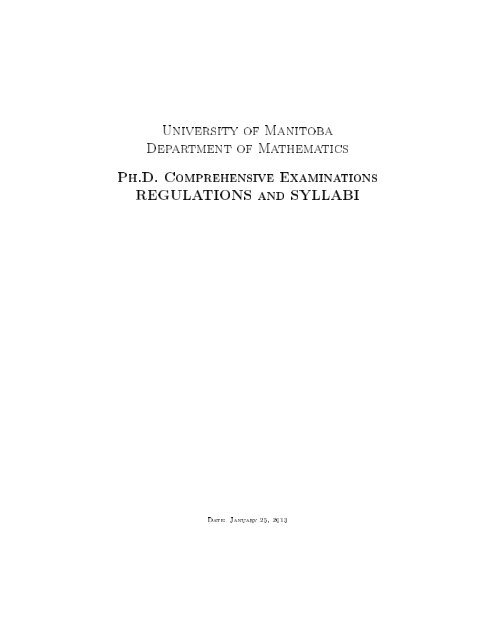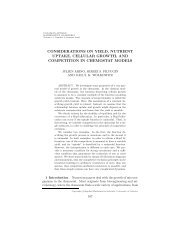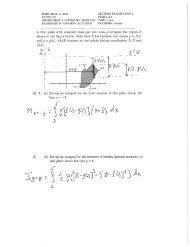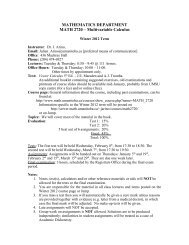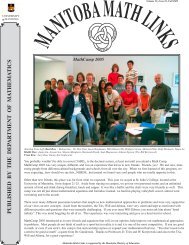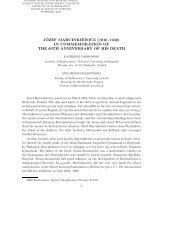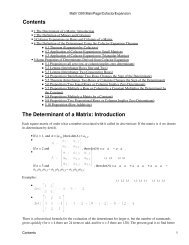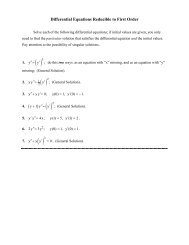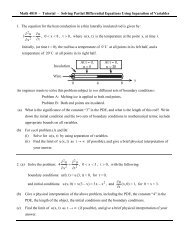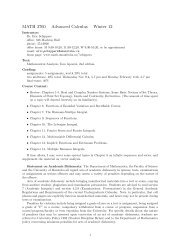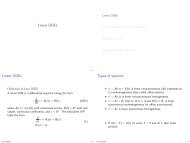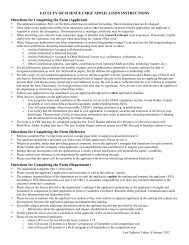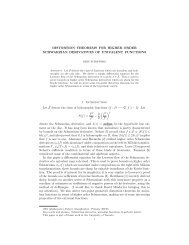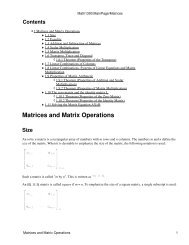Regulations for Comprehensive Exams - University of Manitoba
Regulations for Comprehensive Exams - University of Manitoba
Regulations for Comprehensive Exams - University of Manitoba
You also want an ePaper? Increase the reach of your titles
YUMPU automatically turns print PDFs into web optimized ePapers that Google loves.
<strong>University</strong> <strong>of</strong> <strong>Manitoba</strong><br />
Department <strong>of</strong> Mathematics<br />
Ph.D. <strong>Comprehensive</strong> Examinations<br />
REGULATIONS and SYLLABI<br />
Date: January 25, 2013
<strong>Regulations</strong> Page 1 <strong>of</strong> 4<br />
Ph.D. <strong>Comprehensive</strong> Examinations<br />
A. <strong>Regulations</strong><br />
1. From the Department <strong>of</strong> Mathematics Supplemental <strong>Regulations</strong> <strong>for</strong> the Ph.D. Program:<br />
The candidacy examination in the Ph.D. program in Mathematics consists <strong>of</strong> three separate<br />
written comprehensive examinations chosen from the following areas: a) Algebra; b) Analysis;<br />
c) Combinatorics; d) Computational Mathematics; e) Dierential Equations; f) Geometry;<br />
g) Topology. <strong>Regulations</strong> governing these examinations and the latest syllabi on which these<br />
examinations are based are described in the document "Ph.D. <strong>Comprehensive</strong> Examinations<br />
REGULATIONS and SYLLABI" approved by the Department Council, and are available<br />
from the Associate Head (Graduate Studies). At least one <strong>of</strong> the examinations must be in<br />
Algebra or Analysis. The Graduate Studies Committee arranges comprehensive examinations<br />
twice a year, normally in April and September. The student must register to write a<br />
comprehensive examination by sending a request to the Associate Head (Graduate Studies)<br />
by February 1 if the examination is given in April and by July 1 if the examination is given<br />
in September. The choice <strong>of</strong> areas must be approved by the student's advisor.<br />
The standard <strong>of</strong> pass shall be given on the question sheet <strong>of</strong> each examination. A maximum<br />
<strong>of</strong> two attempts on each comprehensive examination is allowed. A student who fails a<br />
comprehensive examination in any area twice shall be required to withdraw from the Ph.D.<br />
program in Mathematics.<br />
2. Once a student has made a <strong>for</strong>mal request <strong>for</strong> an examination (either in writing or by email),<br />
he/she is obligated to write it (except that a request can be withdrawn be<strong>for</strong>e March 1 if the<br />
examination is given in April and be<strong>for</strong>e August 1 if the examination is given in September).<br />
Absence from the examination on medical or compassionate grounds will be excused according<br />
to the same policies that apply to nal examinations in the Faculty <strong>of</strong> Science. Any other<br />
delay or deferral <strong>of</strong> the examination shall be considered by the Graduate Studies Committee<br />
only upon receipt <strong>of</strong> a written request from a student's advisor (this request must be received<br />
by the Graduate Studies Committee be<strong>for</strong>e the examination) outlining the specic reasons<br />
<strong>for</strong> the delay or deferral.<br />
3. Each Examining Committee shall consist <strong>of</strong> at least three persons. One member <strong>of</strong> each<br />
committee will be designated as Coordinator and will be responsible <strong>for</strong> communicating with<br />
the students, with the Graduate Studies Committee through the Associate Head (Graduate<br />
Studies) and with the Department oce (through the Administrative Assistant).<br />
The Examining Committee sets the questions <strong>for</strong> the examination as it sees t. Once the<br />
examination has reached its nal <strong>for</strong>m it is the responsibility <strong>of</strong> every committee member to<br />
read the entire examination and ensure that it is consistent with the syllabus and with the<br />
general level <strong>of</strong> diculty expected.<br />
The Coordinator is responsible <strong>for</strong> ensuring that all the regulations in this document are<br />
adhered to.<br />
4. This regulation applies to all comprehensive examinations unless the syllabus <strong>for</strong><br />
an examination explicitly overrides it.<br />
Style <strong>of</strong> the examination:<br />
The examination shall consist <strong>of</strong> up to three parts A, B and C.<br />
a) Part A shall consist <strong>of</strong> N 1 mandatory questions, worth a total <strong>of</strong> W 1 marks (individual<br />
marks <strong>for</strong> each question may or may not be the same).<br />
Last updated: December 8, 2011<br />
Approved by the Department Council on May 19, 2011<br />
Amended by the Department Council on May 24, 2011
<strong>Regulations</strong> Page 2 <strong>of</strong> 4<br />
b) Part B (if any) shall provide a choice <strong>of</strong> N 2 questions worth ω 2 marks each with the<br />
instruction that the student is allowed to attempt M 2 out <strong>of</strong> N 2 questions (M 2 shall<br />
be strictly less than N 2 ) with a clear indication <strong>of</strong> which M 2 questions he/she wants to<br />
have marked (and so the maximum marks that a student can obtain in this part shall be<br />
W 2 := ω 2 M 2 ).<br />
c) Part C (if any) shall provide a choice <strong>of</strong> N 3 questions worth ω 3 marks each with the<br />
instruction that the student is allowed to attempt M 3 out <strong>of</strong> N 3 questions (M 3 shall<br />
be strictly less than N 3 ) with a clear indication <strong>of</strong> which M 3 questions he/she wants to<br />
have marked (and so the maximum marks that a student can obtain in this part shall be<br />
W 3 := ω 3 M 3 ).<br />
It is up to the Examining Committee to decide how many questions will be in each part and<br />
how many marks will each part be worth (i.e., there are no restrictions on the values <strong>of</strong> N i ,<br />
M i and W i ), and there is no obligation to follow the <strong>for</strong>mat/style <strong>of</strong> past examinations.<br />
Passing criteria:<br />
One <strong>of</strong> the following two options shall be decided upon by the Examining Committee and<br />
made explicit on the examination paper.<br />
Option 1: In order to pass the examination the student needs to obtain at least 80% overall,<br />
i.e., the minimum passing mark shall be 4 5 (W 1 + W 2 + W 3 ).<br />
Option 2: In order to pass the examination the student needs to obtain at least 70% in each<br />
<strong>of</strong> parts A, B and C (if any), i.e., in order to pass the examination the student needs at<br />
least 7<br />
10 W 1 marks in part A, at least 7<br />
10 W 2 marks in part B, and at least 7<br />
10 W 3 marks in<br />
part C (if any).<br />
5. The style <strong>of</strong> the examination (i.e., the number <strong>of</strong> parts and their description explicitly mentioning<br />
the values <strong>for</strong> N i , M i and W i ), its duration (i.e., the total number <strong>of</strong> hours available<br />
<strong>for</strong> the entire examination and/or the number <strong>of</strong> hours available <strong>for</strong> each part), and the explicit<br />
passing criteria (in the style <strong>of</strong> Options 1 or 2 described in the section A4) shall be<br />
provided on the examination paper (in a manner understandable to a student). The Examining<br />
Committee may provide additional instructions, recommendations, expectations and/or<br />
any other in<strong>for</strong>mation on the examination paper as well.<br />
All the in<strong>for</strong>mation described above in this section shall be communicated to student(s)<br />
1 (one) working day be<strong>for</strong>e the examination date. (For example, the rst page <strong>of</strong> the examination<br />
can contain this in<strong>for</strong>mation and be set up by the Examining Committee so that it<br />
could be photocopied and given to student(s).)<br />
6. The Examining Committee assigns the task <strong>of</strong> detailed grading <strong>of</strong> the various problems on<br />
each examination paper among the Committee members as it sees t.<br />
In particular, individual examiners may be assigned particular questions to grade; or every<br />
examiner may be asked to grade the entire examination in detail. However, regardless <strong>of</strong><br />
the particular methods used, in the end it is the responsibility <strong>of</strong> every Committee member<br />
to read the entire paper, and to <strong>for</strong>m at least a general opinion <strong>of</strong> the per<strong>for</strong>mance <strong>of</strong> the<br />
student.<br />
7. No member <strong>of</strong> the Examining Committee shall write on a student's original examination<br />
paper. Copies <strong>of</strong> the paper shall be made <strong>for</strong> each examiner's personal use.<br />
8. After all the papers have been graded the Examining Committee shall have a meeting (virtual<br />
meeting or meeting by email is allowed) to decide on the marks to be given <strong>for</strong> each question<br />
on each <strong>of</strong> the examination papers. The Examining Committee decides how these marks are<br />
Last updated: December 8, 2011<br />
Approved by the Department Council on May 19, 2011<br />
Amended by the Department Council on May 24, 2011
<strong>Regulations</strong> Page 3 <strong>of</strong> 4<br />
to be given as it sees t (<strong>for</strong> example, by rounding the averages <strong>of</strong> the marks given by<br />
each examiner, by re-marking each problem in a committee, etc.). Once this marking is<br />
complete, the Examining Committee shall use the pass criteria already set and indicated<br />
on the examination paper to determine if the student passes or fails the examination. All the<br />
marks decided upon by the Examining Committee but not marks by individual examiners,<br />
and the results <strong>of</strong> the examination (pass or fail) shall be reported by the Coordinator to<br />
the Associate Head (Graduate Studies) in writing (the results shall be reported only as pass<br />
or fail, reports <strong>of</strong> the sort passed/failed notwithstanding are not allowed and shall not be<br />
accepted). None <strong>of</strong> this in<strong>for</strong>mation shall be made available to students, their advisors or<br />
anybody else until after the appeal period is over (see section A11).<br />
The Coordinator shall be responsible <strong>for</strong> <strong>for</strong>warding the originals <strong>of</strong> the examination papers<br />
to the Department oce <strong>for</strong> storage.<br />
9. During the appeal period, neither the Coordinator nor the Committee shall communicate<br />
with the students, their advisors or anybody else other than the Associate Head (Graduate<br />
Studies) and the Department Head on any matter pertaining to the examination unless the<br />
Associate Head or the Department Head instructs otherwise (in writing).<br />
10. The Associate Head (Graduate Studies) or Department Head shall announce the results<br />
<strong>for</strong>mally to each <strong>of</strong> the students by means <strong>of</strong> a letter on Department letterhead. A copy <strong>of</strong><br />
each letter must be provided to the Department oce <strong>for</strong> the student's les. In the case<br />
<strong>of</strong> a failure, the letter shall in<strong>for</strong>m the student <strong>of</strong> the right to appeal the outcome (with a<br />
reminder about the internal two week deadline). In the case <strong>of</strong> a rst failure, the letter shall<br />
in<strong>for</strong>m the student <strong>of</strong> the possibility to rewrite the examination; and in the case <strong>of</strong> a second<br />
failure on a given examination that this result means that the student will be required by the<br />
Faculty <strong>of</strong> Graduate Studies to withdraw from the Ph.D. program.<br />
11. In the case that a rst failure has been reported, and after the appeal period is over, it is the<br />
responsibility <strong>of</strong> the Coordinator to ensure that the student receives general feedback on the<br />
reasons <strong>for</strong> the failure and some guidance in study and preparation <strong>for</strong> the second attempt.<br />
However, actual marks given <strong>for</strong> each question or total marks received <strong>for</strong> the examination<br />
shall not be revealed or discussed.<br />
12. After the result <strong>of</strong> the examination has been announced, the student may view a copy <strong>of</strong><br />
his/her examination paper in the Department oce, under supervision. Students shall not<br />
be allowed to make any copies <strong>of</strong> any <strong>of</strong> the examination papers at any time.<br />
13. Appeals. If a student wishes to appeal the result <strong>of</strong> his/her examination, a <strong>for</strong>mal appeal in<br />
writing must be addressed to and received by the Department Head within 10 (ten) working<br />
days <strong>of</strong> the announcement <strong>of</strong> the result to the student.<br />
B. Advice to students preparing <strong>for</strong> Ph.D. <strong>Comprehensive</strong> Examinations<br />
1. A Graduate <strong>Comprehensive</strong> Examination in the Department <strong>of</strong> Mathematics is an examination<br />
<strong>of</strong> material that might normally be taught in an undergraduate honours program. For<br />
greater clarity, any material that is covered by the syllabus may appear on a comprehensive<br />
examination irrespectively <strong>of</strong> whether or not it has been (or is) taught in undergraduate or<br />
graduate courses at the <strong>University</strong> <strong>of</strong> <strong>Manitoba</strong> or any other institution.<br />
Additionally, since it is impractical (if not impossible) to list all possible denitions/concepts<br />
in the syllabus, it should be understood that topics related to those in the syllabus are also<br />
covered. For example, if a section <strong>of</strong> a book is covered by a syllabus, and a topic is discussed<br />
Last updated: December 8, 2011<br />
Approved by the Department Council on May 19, 2011<br />
Amended by the Department Council on May 24, 2011
<strong>Regulations</strong> Page 4 <strong>of</strong> 4<br />
in this section, then this topic may be covered by the examination even if that specic concept<br />
is not explicitly mentioned in the syllabus. It goes without saying that you should also know<br />
all the basic material that is a prerequisite <strong>for</strong> the topics that are covered by the syllabus.<br />
Even though comprehensive examinations are based on undergraduate material, they are<br />
being written by Ph.D. students, and so a more sophisticated level <strong>of</strong> understanding and<br />
presentation may be expected than might normally be demanded in relevant undergraduate<br />
courses.<br />
2. Copies <strong>of</strong> old comprehensive examinations may be available from the Department oce or<br />
from the Department website. However, you should have ABSOLUTELY NO EXPECTA-<br />
TIONS that future examinations will be identical or even remotely similar to any particular<br />
previous examination. Do not base your expectations <strong>for</strong> the examination on any particular<br />
previous examination.<br />
3. Do not limit your study and preparation to one reference; reviewing all references provided<br />
with the syllabus will provide a much better preparation <strong>for</strong> dierent styles <strong>of</strong> questions.<br />
4. Do not expect the examination to follow the <strong>for</strong>mat or style <strong>of</strong> any particular undergraduate<br />
courses within the Department <strong>of</strong> Mathematics. Texts and old examinations from relevant<br />
undergraduate courses may be useful as a study supplement, but the Graduate <strong>Comprehensive</strong><br />
Examinations are not based explicitly on our undergraduate courses.<br />
5. Do not expect any Faculty member to teach you the subject matter <strong>of</strong> the examination<br />
(outside the regular coursework). You are admitted to our Ph.D. program on the basis that<br />
you are (mostly) prepared <strong>for</strong> work at this level, including being prepared (or having the<br />
mathematical maturity to be able to prepare) <strong>for</strong> the <strong>Comprehensive</strong> Examinations. You<br />
should be able to prepare <strong>for</strong> these examinations by reviewing <strong>of</strong> your earlier studies, and by<br />
self-studying <strong>of</strong> any subjects that you have missed.<br />
6. Faculty members may be able to advise you on relevant study plans, be helpful with specic<br />
diculties that you may have, and so on. The Associate Head (Graduate Studies) can help<br />
clarify the regulations; the Coordinator <strong>of</strong> the Examining Committee may help you interpret<br />
the details <strong>of</strong> the Examination Syllabus; and members <strong>of</strong> Faculty working in the general area<br />
<strong>of</strong> the Examination are <strong>of</strong>ten available <strong>for</strong> help with specic questions.<br />
7. Expect a mixture <strong>of</strong> theoretical and practical problems, sometimes in the same question.<br />
Classifying questions as theoretical or practical is in many cases arbitrary, and a comprehensive<br />
examination in any case may (and <strong>of</strong>ten will) cover the entire range <strong>of</strong> styles <strong>of</strong> questions<br />
suitable to the subject area.<br />
Last updated: December 8, 2011<br />
Approved by the Department Council on May 19, 2011<br />
Amended by the Department Council on May 24, 2011
Algebra Page 1 <strong>of</strong> 3<br />
Algebra <strong>Comprehensive</strong> Examination Syllabus<br />
1. Linear Algebra.<br />
⊲ Vector spaces over R, C, nite elds and general elds.<br />
⊲ Subspaces. Linear independence, generating (spanning) sets, bases. Dimension. Innite<br />
dimensional vector spaces. Direct sums. Every vector space has a basis (application <strong>of</strong><br />
Zorn's Lemma or equivalent).<br />
⊲ Matrices. Matrix algebra. Inverses <strong>of</strong> matrices. Singular matrices. Determinants. Rank <strong>of</strong><br />
matrices. Equivalent conditions <strong>for</strong> nonsingularity. Row space, column space, null space,<br />
rank <strong>of</strong> matrices and their interrelations.<br />
⊲ The theory <strong>of</strong> systems <strong>of</strong> linear equations. Elementary matrices. Gaussian Elimination.<br />
The reduced row echelon <strong>for</strong>m. Solution space <strong>of</strong> a homogeneous system, particular and<br />
general solutions <strong>of</strong> an arbitrary system.<br />
⊲ Linear trans<strong>for</strong>mations. Representations by matrices in the nite dimensional case. Fundamental<br />
subspaces associated with a trans<strong>for</strong>mation (kernel, range). Fundamental subspaces<br />
associated with a matrix and their connection to linear trans<strong>for</strong>mations. Dimension theorem.<br />
⊲ Linear operators on nite and innite dimensional spaces.<br />
⊲ Linear functionals. Duals <strong>of</strong> both nite and innite dimensional spaces.<br />
⊲ Eigenvalues and eigenvectors <strong>of</strong> a linear operator; <strong>of</strong> a matrix. Characteristic equation <strong>of</strong> a<br />
matrix. The minimal polynomial. Diagonalization <strong>of</strong> matrices (operators) and applications.<br />
Invariant subspaces. Cayley-Hamilton theorem.<br />
⊲ Inner product spaces. Cauchy-Schwarz theorem. Orthogonal complements. The Gram-<br />
Schmidt algorithm. Adjoint <strong>of</strong> a linear operator. Unitary, self-adjoint, normal and orthogonal<br />
operators and their matrices. Diagonalization and self-adjoint operators.<br />
⊲ Jordan canonical <strong>for</strong>m.<br />
⊲ Bilinear <strong>for</strong>ms and their representations. Quadratic <strong>for</strong>ms. Positive denite and positive<br />
semidenite bilinear <strong>for</strong>ms.<br />
2. Group Theory.<br />
⊲ Semigroups, monoids, groups. Left and right inverses, units, idempotents. Order <strong>of</strong> an<br />
element <strong>of</strong> a group, order <strong>of</strong> a group. Cyclic groups. Permutation groups, Cayley's representation<br />
theorem. Group actions, stabilizer, orbit.<br />
⊲ Subgroups, cosets, normal subgroups. Lagrange's theorem.<br />
⊲ Homomorphisms and endomorphisms. Normal groups and factor groups. Isomorphism<br />
theorems. Simple groups. Commutator subgroup. Automorphisms, inner automorphisms.<br />
⊲ Centre, centralizer, normalizer, conjugate subgroups. Class equation.<br />
⊲ Sylow Theorems. p-groups, Sylow p-subgroups. Applications <strong>of</strong> the Sylow theorems. Nilpotent<br />
groups.<br />
⊲ Direct product (internal and external) <strong>of</strong> groups.<br />
⊲ Free abelian groups. The structure <strong>of</strong> nitely generated abelian groups, <strong>of</strong> nite abelian<br />
groups.<br />
Last updated: July 6, 2011<br />
Approved by the Department Council on July 6, 2011
Algebra Page 2 <strong>of</strong> 3<br />
⊲ Presentations (generators and relations). Free Groups.<br />
⊲ Normal series, composition series. Zassenhaus Lemma, Schreier's Renement Theorem,<br />
Jordan-Hölder Theorem. Solvable groups.<br />
3. Ring Theory.<br />
⊲ Rings, domains, elds, division rings. The ring <strong>of</strong> endomorphisms <strong>of</strong> an abelian group.<br />
Matrix rings. Characteristic. Subrings. Ideals. Homomorphisms and quotient (factor)<br />
rings. Isomorphism theorems.<br />
⊲ Embedding an integral domain in a eld (quotient eld construction).<br />
⊲ Ideals <strong>of</strong> a commutative ring. Prime ideals, Maximal ideals. Chinese Remainder Theorem<br />
<strong>for</strong> commutative rings.<br />
⊲ Unique Factorization Domains, Principal Ideal Domains, Euclidean Domains and the relations<br />
between them. Factorization theory in integral domains.<br />
⊲ Polynomial rings. Extension <strong>of</strong> a homomorphism on R to a homomorphism on R[x] . Polynomial<br />
rings over integral domains, unique factorization domains, and elds. Hilbert Basis<br />
Theorem. Factorization theory in polynomial rings. Irreducibility and Eisenstein's Criterion.<br />
⊲ Chain conditions (ascending chain condition, descending chain condition), noetherian and<br />
artinian rings. Existence <strong>of</strong> maximal ideals and prime ideals (application <strong>of</strong> Zorn's Lemma<br />
or equivalent).<br />
4. Field Theory and Galois Theory.<br />
⊲ Finite elds, order <strong>of</strong> nite elds. Prime subelds.<br />
⊲ Field extensions. Finite, algebraic, and nitely generated extensions. Primitive elements.<br />
Minimal polynomial. Roots <strong>of</strong> polynomials. Adding a root <strong>of</strong> a polynomial. Transcendental<br />
extensions and transcendance degree.<br />
⊲ Quadratic extensions, straightedge and compass constructions.<br />
⊲ Splitting elds. Roots <strong>of</strong> unity. Cyclotomic extensions. Algebraically closed elds and their<br />
construction.<br />
⊲ Automorphism groups <strong>of</strong> eld extensions. Separable and normal extensions. Subeld xed<br />
by a group <strong>of</strong> automorphisms. Galois extensions and the Galois group <strong>of</strong> an extension.<br />
Fundamental Theorem <strong>of</strong> Galois Theory.<br />
⊲ Determining the Galois group <strong>of</strong> a polynomial. Galois group <strong>of</strong> the splitting eld <strong>of</strong> a<br />
polynomial and permutations <strong>of</strong> the roots <strong>of</strong> the polynomial.<br />
⊲ Extensions by radicals. Equations solvable by radicals. The general equation <strong>of</strong> degree n<br />
and its Galois group. Non-solvability <strong>of</strong> the general equation <strong>of</strong> degree n ≥ 5 , by radicals.<br />
5. Module Theory.<br />
⊲ Modules over a ring. Abelian groups, vector spaces, and ideals as modules. Submodules,<br />
homomorphisms, quotient modules. Isomorphism theorems. The ring <strong>of</strong> endomorphisms <strong>of</strong><br />
a module.<br />
⊲ Product, direct sum, tensor product and their characterization by universal properties. The<br />
Hom functor. Short exact sequences and preservation <strong>of</strong> exactness.<br />
Last updated: July 6, 2011<br />
Approved by the Department Council on July 6, 2011
Algebra Page 3 <strong>of</strong> 3<br />
⊲ Injective, free, projective, and at modules.<br />
6. Lattice Theory.<br />
⊲ Partially ordered sets, chains, and lattices, especially as these concepts occur in topics 15.<br />
Lattices as posets and as algebras.<br />
⊲ Distributive and modular lattices. Characterization in terms <strong>of</strong> excluded sublattices. Distributivity<br />
<strong>of</strong> the divisibility lattice <strong>of</strong> the natural numbers. Modularity <strong>of</strong> the lattice <strong>of</strong><br />
normal subgroups, the lattice <strong>of</strong> one-sided ideals, the lattice <strong>of</strong> submodules.<br />
⊲ Complete lattices.<br />
⊲ Properties <strong>of</strong> the lattices that arise naturally in linear algebra, in group theory, in ring<br />
theory and in module theory.<br />
⊲ Chain conditions. Equivalent <strong>for</strong>mulations <strong>of</strong> ACC, DCC. Ordered set constructions in<br />
algebra (unions <strong>of</strong> chains, unions <strong>of</strong> directed sub-families).<br />
Suggested reading list:<br />
• Primary references:<br />
[1] P. M. Cohn, Classic Algebra. [QA 154.2 C63 2000].<br />
[Chapters 19, 10.110.5, 10.8, 10.11, 11.111.5, Appendix 1]<br />
[2] P. M. Cohn, Basic Algebra: Groups, Rings, and Fields. [QA 154.3 C64 2003].<br />
[Sections 1.1, 1.2, 2.12.5, 3.1, 3.2, 4.1, 4.2, 4.44.8, 7]<br />
The rest <strong>of</strong> this book is well beyond the scope <strong>of</strong> this syllabus.<br />
• For an in-depth review <strong>of</strong> Linear Algebra and Galois Theory:<br />
[3] K. Homan and R. Kunze, Linear Algebra. [QA 252 H67 1971].<br />
[4] I. Stewart, Galois Theory. [QA 214 S74 2004].<br />
• Additional reading:<br />
[5] M. Artin, Algebra, 2nd ed. [QA 154.2 A77 2011].<br />
[6] J. B. Fraleigh, A First Course in Abstract Algebra, 3rd ed. [QA 162 F7 1982].<br />
[7] I. N. Herstein, Topics in Algebra. [QA 155 H4 1954].<br />
(Not Abstract Algebra, which is more elementary)<br />
[8] N. Jacobson, Basic Algebra, Vol. I. [QA 154.2 J32 1985 V.1].<br />
[9] S. Lang, Algebra. [QA 154 L35 1965].<br />
(Not Undergraduate Algebra, which is more elementary)<br />
The exam questions are not selected from any one reference or references.<br />
Last updated: July 6, 2011<br />
Approved by the Department Council on July 6, 2011
Analysis Page 1 <strong>of</strong> 3<br />
Analysis <strong>Comprehensive</strong> Examination Syllabus<br />
I. Mathematical Analysis<br />
Students are expected to know all basic mathematical analysis/calculus (see, e.g., [2, Chapters<br />
1-9] and corresponding sections from [1]). In addition, the following topics are covered:<br />
⊲ Functions <strong>of</strong> bounded variation: Monotonic functions, Total variation, Functions <strong>of</strong> bounded<br />
variation expressed as the dierence <strong>of</strong> increasing functions.<br />
⊲ Riemann and Riemann-Stieltjes integral: Denition and elementary properties, Integration<br />
by parts, Change <strong>of</strong> variable, Step functions as integrators, Reduction <strong>of</strong> Riemann-<br />
Stieltjes integral to a nite sum, Fundamental theorems <strong>of</strong> integral calculus.<br />
⊲ Sequences <strong>of</strong> functions: Pointwise and uni<strong>for</strong>m convergence, Uni<strong>for</strong>m convergence and<br />
continuity, Cauchy condition <strong>for</strong> uni<strong>for</strong>m convergence, Uni<strong>for</strong>m convergence <strong>of</strong> innite<br />
series <strong>of</strong> functions, Uni<strong>for</strong>m convergence and Riemann-Stieltjes integration, Uni<strong>for</strong>m convergence<br />
<strong>of</strong> improper integrals, Uni<strong>for</strong>m convergence and dierentiation, Sucient conditions<br />
<strong>for</strong> uni<strong>for</strong>m convergence <strong>of</strong> a series (Weierstrass M-test, Dirichlet's test).<br />
⊲ Weierstrass approximation theorem.<br />
⊲ Inverse function theorem. Implicit function theorem. Theorems <strong>of</strong> Green, Gauss and<br />
Stokes.<br />
⊲ Fourier series: Orthogonal systems <strong>of</strong> functions, Theorem on best approximations, Fourier<br />
series <strong>of</strong> a function relative to an orthonormal system, Properties <strong>of</strong> the Fourier coecients,<br />
Riesz-Fischer theorem.<br />
References:<br />
The material covered in this part may be found in Sections 6.1-6.7, 7.1-7.9, 7.19, 7.20, 9.1-9.11,<br />
10.13, 11.1-11.6, 11.15 <strong>of</strong> [1] and [2, Chapters 1-9].<br />
[1] Tom M. Apostol, Mathematical analysis, 2nd ed., Addison-Wesley Publishing Co., Reading,<br />
Mass.-London-Don Mills, Ont., 1974.<br />
[2] R. Creighton Buck, Advanced calculus, 3rd ed., Waveland Pr. Inc., January 1, 2003.<br />
II. Real Variables<br />
⊲ Lebesgue Measure<br />
Lebesgue outer measure, Measurable sets and Lebesue measure, G δ and F σ sets, Existence<br />
<strong>of</strong> a non-measurable set, Measurable functions, Egorov's Theorem.<br />
⊲ Lebesgue Integral<br />
Denition and properties <strong>of</strong> Lebesgue integral, Fatou's Lemma, Monotone convergence<br />
theorem, Dominated convergence theorem, Convergence in measure.<br />
⊲ Dierentiation and Integration<br />
Vitali's cover and Vitali's theorem, Integral <strong>of</strong> the derivative <strong>of</strong> an increasing function,<br />
Dierentiation <strong>of</strong> the indenite integral, Absolutely continuous functions.<br />
⊲ L p - Spaces<br />
The Minkowski and Holder inequalities, Completeness, Dual spaces <strong>of</strong> L p - spaces (Riesz<br />
representation theorem).<br />
Last updated: January 11, 2013<br />
Approved by the Department Council on May 19, 2011
Analysis Page 2 <strong>of</strong> 3<br />
⊲ Normed Spaces<br />
Denition <strong>of</strong> normed and Banach spaces, Subspaces , Quotient spaces, Linear operators<br />
and functionals, Equivalent conditions <strong>for</strong> continuity <strong>of</strong> linear operators, Spaces <strong>of</strong><br />
bounded linear operators, Hahn-Banach theorem, Embedding <strong>of</strong> a normed space into its<br />
second dual, Reexive Banach spaces, Closed graph theorem, Open mapping theorem,<br />
Baire category in metric spaces, Principle <strong>of</strong> uni<strong>for</strong>m boundedness.<br />
⊲ Abstract Measure and Integration<br />
Measure spaces, Measurable functions, Simple functions, Denition <strong>of</strong> abstract integral,<br />
linearity with respect to integrand and additivity with respect to domain <strong>of</strong> integration,<br />
Convergence theorems (Monotone, Dominated, Fatou's lemma). Signed measures, Complex<br />
measures, Theorem <strong>of</strong> Hahn <strong>for</strong> signed measures, Absolute continuity and singularity<br />
<strong>for</strong> measures, total variation <strong>of</strong> a measure, Radon Nikodym theorem, Lebesue decomposition<br />
theorem, Outer measures, Measures derived from outer measures, Extension <strong>of</strong> a<br />
measure on an algebra (semi-algebra) to a measure on a σ-algebra. Caratheodory theorem,<br />
Product measures and theorems <strong>of</strong> Fubini and Tonneli.<br />
References:<br />
The material covered in this part may be found in Chapters 1-7, 10-12 <strong>of</strong> [3].<br />
[3] H. L. Royden, Real analysis, 3rd ed., Macmillan Publishing Company, New York, 1988.<br />
III. Complex Analysis<br />
⊲ Basic properties <strong>of</strong> complex numbers and analytic functions, Elementary analytic functions,<br />
Entire Functions, Cauchy-Riemann Theorem, Inverse Function Theorem.<br />
⊲ Contour Integrals, Cauchy's Theorem, Cauchy's Integral Formula, Cauchy's Inequalities,<br />
Liouville's Theorem, Fundamental Theorem <strong>of</strong> Algebra, Morera's Theorem, Maximum<br />
Modulus Theorem, Schwartz Lemma.<br />
⊲ Convergent series <strong>of</strong> analytic functions, Taylor series, Laurent series, Zeros <strong>of</strong> analytic<br />
functions and classication <strong>of</strong> singularities, Casorati-Weierstrass Theorem.<br />
⊲ Residue Theorem and evaluation <strong>of</strong> integrals by using the Residue Theorem.<br />
⊲ Con<strong>for</strong>mal mappings and linear fractional trans<strong>for</strong>mations.<br />
⊲ Identity Theorem, Rouche's Theorem and Principal <strong>of</strong> the Argument Theorem, Hurwitz's<br />
theorem, Open Mapping Theorem <strong>for</strong> analytic functions.<br />
⊲ Spaces <strong>of</strong> analytic functions, Normal families, Montel's theorem, Riemann mapping theorem,<br />
Harmonic functions, Mean Value Property <strong>for</strong> harmonic functions, Maximum Modulus<br />
Theorems <strong>for</strong> harmonic functions, Solution <strong>of</strong> the Dirichlet problem on a disk, Harnack's<br />
inequality and Harnack's Theorem.<br />
References:<br />
The material covered in this part may be found in [4, Chapters 1-6] and [5, Chapters VII and<br />
X].<br />
[4] Jerrold E. Marsden and Michael J. Homan, Basic complex analysis, 3rd ed., W. H. Freeman<br />
and Company, New York, 1999.<br />
Last updated: January 11, 2013<br />
Approved by the Department Council on May 19, 2011
Analysis Page 3 <strong>of</strong> 3<br />
[5] John B. Conway, Functions <strong>of</strong> one complex variable, 2nd ed., Graduate Texts in Mathematics,<br />
vol. 11, Springer-Verlag, New York, 1978.<br />
Further suggested reading:<br />
[6] Walter Rudin, Real and complex analysis, 3rd ed., McGraw-Hill Book Co., New York, 1987.<br />
Last updated: January 11, 2013<br />
Approved by the Department Council on May 19, 2011
Combinatorics Page 1 <strong>of</strong> 3<br />
Combinatorics <strong>Comprehensive</strong> Examination Syllabus<br />
The combinatorics comprehensive exam covers two mandatory areas: core combinatorial concepts<br />
(Section 1, below) and graph theory (Section 2). The student selects a third area, either design<br />
theory (Section 3) or coding theory (Section 4); the student must identify the selected area at the<br />
time a request to write the exam is made. For study purposes, the three areas may constitute an<br />
approximate 40:35:25 distribution <strong>of</strong> available marks (it is up to the examining committee to decide<br />
on the exact distribution <strong>of</strong> marks).<br />
Unless otherwise noted, the student is expected to know pro<strong>of</strong>s <strong>of</strong> named theorems and <strong>of</strong> main<br />
theorems <strong>of</strong> each topic covered. The student is assumed to have a working knowledge <strong>of</strong> modular<br />
arithmetic, nite elds, and mathematical induction.<br />
1 Core combinatorial concepts<br />
⊲ Basic counting: Rules (incl. Product rule, Sum rule), permutations, r-permutations,<br />
subsets, r-combinations, probability, sampling with replacement, occupancy problems<br />
(e.g., distinguishable balls into indistinguishable cells), Stirling numbers <strong>of</strong> the second<br />
kind, multinomial coecients, binomial expansion, generating permutations and combinations,<br />
lexicographic order, Gray codes, algorithms and complexity, big oh notation,<br />
pigeonhole principle, small Ramsey numbers, partitions <strong>of</strong> integers and Ferrer diagrams.<br />
⊲ Relations: Binary relations, order (linear, partial), linear extensions, chains, antichains,<br />
Dilworth's theorem, interval orders, lattices and boolean algebras, distributive and complemented<br />
lattices [modular lattices not in this syllabus], lexicographic order.<br />
⊲ Generating functions: Sampling without replacement, integer solutions <strong>of</strong> equations,<br />
partitions <strong>of</strong> integers, binomial theorem, Exponential generating functions, counting permutations,<br />
distinguishable balls into indistinguishable cells.<br />
⊲ Recurrence relations: Fibonacci numbers, derangements, method <strong>of</strong> characteristic<br />
roots, Recurrences involving convolutions, Catalan numbers (including counting lattice<br />
paths, triangulations).<br />
⊲ Principle <strong>of</strong> inclusion and exclusion: Counting derangements, number <strong>of</strong> objects<br />
having exactly m properties, hatcheck problem.<br />
⊲ Classical problems in designs: Kirkman's school girl problem, including resolvable<br />
STS, the problem <strong>of</strong> 36 ocers, Euler's conjecture on the existence <strong>of</strong> orthogonal pairs<br />
<strong>of</strong> latin squares.<br />
References <strong>for</strong> core concepts<br />
[1] F. S. Roberts and B. Tesman, Applied combinatorics, 2nd ed., Pearson Prentice Hall, Upper<br />
Saddle River, NJ, 2005.<br />
See Chapters 17, in particular, sections 2.1, 2.2, 2.3, 2.5, 2.6, 2.7, 2.8, 2.9, 2.10, 2.11, 2.14,<br />
2.16, 2.18, 2.19, 4.1, 4.2 [omit weak orders], 4.3, 4.4, 5.15.5 [omit 5.1.4, omit Examples<br />
5.21, 5.22], 6.1, 6.2, 6.4, 6.6, 7.1 [omit 7.1.6, 7.19], 7.2.<br />
[2] Richard A. Brualdi, Introductory combinatorics, 5th ed., Pearson Prentice Hall, 2010.<br />
[QA164.B76.2010].<br />
All chapters except Chapter 13. For topics not in [1], see pp. 1114, Section 7.7, Section<br />
8.1, pp. 265273, Section 8.3, pp. 291top <strong>of</strong> p. 295; p. 303, pp. 367378.<br />
Last updated: January 25, 2013<br />
Approved by the Department Council on January 24, 2013
Combinatorics Page 2 <strong>of</strong> 3<br />
2 Graph theory<br />
⊲ Basic graph theory: Denitions <strong>of</strong> graph and digraph, multigraph, labelled graphs,<br />
isomorphism, degree sequences, trees, paths, cycles, complete graphs, connectedness,<br />
bridges, regular graphs, strongly connected digraphs, Eulerian graphs, Eulerian digraphs<br />
and multigraphs, Hamiltonian graphs, graph colouring, planar graphs, Kuratowski's theorem<br />
(no pro<strong>of</strong>), 2-colourable graphs, chromatic number, independent sets, list colourings,<br />
trees, spanning trees, equivalent conditions <strong>for</strong> a tree, chemical bonds, Cayley's theorem<br />
<strong>for</strong> labelled trees and Prüfer sequences, incidence matrix and adjacency matrix, Ramsey<br />
numbers and graphs.<br />
⊲ Graph theory optimization: Depth-rst search, connectivity (vertex and edge), spanning<br />
tree, Robbin's theorem <strong>for</strong> one-way streets, Eulerian circuits and trails, applications<br />
<strong>of</strong> Euler's theorem, Chinese postman problem, street sweeping, DeBruijn sequences, shift<br />
register sequences, rotating drum problem, Travelling Salesman Problem (TSP), Ore's<br />
condition, Dirac's condition, applications <strong>of</strong> hamiltonian cycles and paths in graphs or<br />
digraphs, including tournaments.<br />
⊲ Matching and covering: Applications, bipartite matchings, Philip Hall's condition<br />
and theorem (with pro<strong>of</strong>), matchings in regular bipartite graphs, systems <strong>of</strong> distinct representatives<br />
(SDRs), extending Latin rectangles, maximum matchings and minimum coverings,<br />
König's theorem (with pro<strong>of</strong>), nding a maximum matching, augmenting chains,<br />
Ford-Fulkerson algorithm, stable matchings, Gale-Shapley algorithm.<br />
⊲ Optimization problems <strong>for</strong> graphs and networks: Minimum spanning trees, Kruskal's<br />
algorithm, Prim's algorithm, shortest path algorithms, Dijkstra's algorithm, network<br />
ows, max ows, min cuts, max-ow min-cut theorem, Menger's theorems, applications<br />
<strong>of</strong> min-cost ow problems (transportation problem and optimal assignment problem).<br />
⊲ Other topics: Fleury's algorithm, Euler's theorem <strong>for</strong> planar graphs or polyhedra and<br />
platonic solids, the Four Colour Theorem (no pro<strong>of</strong>), nite Ramsey's theorem (<strong>for</strong> twocolouring<br />
<strong>of</strong> pairs) and pro<strong>of</strong> using the Erd®s-Szekeres recursion, binary reected Gray<br />
codes and hamiltonian cycles on the n-dimensional hypercube, perfect graphs, clique<br />
number.<br />
References <strong>for</strong> graph theory<br />
In [1]: Sections 3.13.3, 3.5 [omit 3.5.7], 3.7, 3.8. 11.1, 11.2 [omit 11.2.4, 11.2.5], 11.3, 11.4<br />
[omit 11.4.4, 11.4.5], 11.5, 11.6.1 [omit 11.6.211.6.5] 12.1, 12.2, 12.4, 12.5, 12.8.1. 13.1,<br />
13.2 [omit 13.2.3], 13.3 [omit 13.3.6, 13.3.7], 13.4 (only Examples 13.11 and 13.12).<br />
[3] Joan M. Aldous and Robin J. Wilson, Graphs and applications; an introductory approach,<br />
Springer, 2000.<br />
See pp. 203, 165170, 203, 251256, 268273.<br />
[4] Béla Bollobás, Modern graph theory, Graduate texts in mathematics 184, Springer, 1998.<br />
Omit Chapter 8. For topics not covered above, see section V.5, pp. 165169, statements<br />
only <strong>of</strong> theorems and the perfect graph conjecture.<br />
In [2]: For topics not covered above, see pp. 7880, 104105.<br />
The following is also a thorough graph theory reference, covering most topics above:<br />
[5] Reinhard Diestel, Graph theory, 2nd ed., Springer, 2000. [Available online].<br />
Last updated: January 25, 2013<br />
Approved by the Department Council on January 24, 2013
Combinatorics Page 3 <strong>of</strong> 3<br />
3 Elementary design theory<br />
Block designs, latin squares, orthogonal latin squares, completion <strong>of</strong> a latin rectangle or semilatin<br />
square to a latin square, nite elds and families <strong>of</strong> latin squares, modular arithmetic<br />
and RSA, construction <strong>of</strong> complete set <strong>of</strong> MOLS from a nite eld, BIBDs, (b, v, r, k, λ)-<br />
designs, existence there<strong>of</strong>, Fisher's inequality (with pro<strong>of</strong>), resolvable designs, SBIBDs, Steiner<br />
triple systems, Kirkman's schoolgirl problem, Kirkman's theorem <strong>for</strong> existence <strong>of</strong> STSs (no<br />
pro<strong>of</strong>), Bruck-Ryser-Chowla theorem (statement only), construction <strong>of</strong> new designs from others,<br />
Steiner systems, Kirkman's school girl problem and problem <strong>of</strong> 36 ocers, nite projective<br />
planes, basic properties, MOLS and (v, k, λ) designs.<br />
References <strong>for</strong> design theory<br />
In [1]: Sections 9.1, 9.2 [omit 9.2.5], 9.3, 9.4.19.4.7, 9.4.9, 9.5.<br />
In [2]: Pages 11-14, 351, 367368, 385388.<br />
4 Basic coding theory<br />
In<strong>for</strong>mation transmission, encoding and decoding, Caesar cyphers, matrix codes, repetition<br />
codes, permutation codes, error-correcting codes, Hamming distance, Hamming bound, probability<br />
<strong>of</strong> error, linear codes, generator matrices, error-correction, Hamming codes, block designs<br />
and error-correcting codes, Hadamard codes, constructing Hadamard matrices, Plotkin's<br />
bound, applications (including Mariner 9 probe, CDs, no theory or pro<strong>of</strong>s). Not covering general<br />
theory <strong>of</strong> Reed-Muller codes, Reed-Soloman, or more advanced codes.<br />
Reference <strong>for</strong> coding theory<br />
In [1]: Sections 10.1, 10.2, 10.3 [omit 10.3.4], 10.4, 10.5.<br />
Last updated: January 25, 2013<br />
Approved by the Department Council on January 24, 2013
Computational Mathematics Page 1 <strong>of</strong> 3<br />
Computational Mathematics <strong>Comprehensive</strong> Examination Syllabus<br />
The Computational Mathematics comprehensive examination consists <strong>of</strong> 3 (three) Parts X, Y and<br />
Z.<br />
• Part X shall be based on the material from section I (Introductory Numerical Analysis).<br />
• Parts Y and Z shall be based on the material from 2 (two) <strong>of</strong> sections II (Finite Element Methods),<br />
III (Numerical Linear Algebra), IV (Finite Dierence Methods) or V (Approximation Theory).<br />
The choice <strong>of</strong> 2 (two) sections <strong>for</strong> Parts Y and Z shall be declared by the student at the time <strong>of</strong><br />
registration <strong>for</strong> the Computational Mathematics comprehensive examination.<br />
I. Introductory Numerical Analysis<br />
⊲ Computer arithmetic and oating-point numbers, relative and absolute errors. Roundo-errors<br />
and their propagation.<br />
⊲ Polynomial Interpolation: Lagrange interpolation, Divided dierences, Natural and clamped<br />
cubic spline interpolation.<br />
⊲ Numerical dierentiation and integration: Richardson's extrapolation, trapezoid and<br />
Simpson's rules, Newton-Cotes <strong>for</strong>mulas, Composite numerical integration, Gaussian<br />
quadratures.<br />
⊲ Least squares approximation, orthogonal polynomials approximation (Legendre and Chebyshev),<br />
and trigonometric polynomial approximation.<br />
⊲ Direct methods <strong>for</strong> solving linear systems: Gaussian elimination, Pivoting methods, Matrix<br />
factorization and special types <strong>of</strong> matrices.<br />
⊲ Iterative methods <strong>for</strong> solving linear systems: Jacobi and Gauss-Seidel iterative methods,<br />
Relaxation methods, Error bounds. Power method <strong>for</strong> eigenvalue problems.<br />
⊲ Numerical solutions <strong>for</strong> nonlinear equations and nonlinear systems: Bisection method,<br />
xed point method, Newton's method, secant method. Error analysis.<br />
⊲ Numerical solution <strong>for</strong> initial value problems <strong>for</strong> ordinary dierential equations: Single<br />
step method (Euler's method, Runge-Kutta methods), Multi-step methods (Adams'<br />
methods, predictor-corrector methods). Local truncation error. Consistency, stability<br />
and convergence <strong>of</strong> numerical methods.<br />
⊲ Numerical solution <strong>for</strong> boundary value problems <strong>of</strong> ordinary dierential equations: Shooting<br />
methods <strong>for</strong> linear and nonlinear problems, nite dierence methods <strong>for</strong> linear and<br />
nonlinear problems.<br />
References:<br />
The material covered in this section may be found in Chapter 2 <strong>of</strong> [1], and Sections 1.2, 2.1-2.4,<br />
3.1, 3.3, 3.5, 4.1-4.4, 4.7, 5.2-5.4, 5.6, 5.9-5.10, 6.1, 6.2, 6.5, 6.6, 7.3-7.5, 8.1-8.3, 8.5, 9.3, 10.1,<br />
10.2, 11.1-11.4. <strong>of</strong> [2].<br />
[1] K. Atkinson and W. Han, Elementary Numerical Analysis, 3rd ed., Wiley-Interscience Publication,<br />
2004.<br />
[2] R. Burden and J. Faires, Numerical Analysis, 9th ed., Brooks/Cole, 2011.<br />
Last updated: May 24, 2011<br />
Approved by the Department Council on May 24, 2011
Computational Mathematics Page 2 <strong>of</strong> 3<br />
II. Finite Element Methods<br />
⊲ Variational <strong>for</strong>mulation and nite element <strong>for</strong>mulation <strong>for</strong> one-dimensional model problems<br />
with Neumann, Dirichlet and mixed boundary conditions. Fundamental properties<br />
<strong>of</strong> the nite element solutions and variational solutions <strong>for</strong> the one-dimensional model<br />
problems.<br />
⊲ A-priori error estimation <strong>for</strong> the h, p and h-p versions <strong>of</strong> nite element method on quasiuni<strong>for</strong>m<br />
meshes. A-posteriori estimation <strong>of</strong> nite element solution by the extrapolation<br />
techniques.<br />
⊲ Method, algorithm and computation <strong>of</strong> nite element solutions <strong>of</strong> the h-p version. Shape<br />
functions. Computation <strong>of</strong> local stiness, mass matrices and local load vector. Assembly<br />
<strong>of</strong> global stiness, mass matrices and global load vector.<br />
References:<br />
The material covered in this section may be found in [3], and Chapters 3 and 4 <strong>of</strong> [4].<br />
[3] B. Guo, Introduction <strong>of</strong> the nite element method: theory and computation <strong>of</strong> the h, p and<br />
h-p version, Lecture notes, 2008.<br />
[4] B. Szabo and I. Babuska, Finite element analysis, Wiley-Interscience Publication, New<br />
York, 1991.<br />
III. Numerical Linear Algebra<br />
⊲ Vector and matrix norms (p−norms, Frobenius norm); condition number.<br />
⊲ Givens and Householder trans<strong>for</strong>mations.<br />
⊲ LU, LL T , QR, Schur and Singular value decompositions, pseudoinverse, projections, least<br />
squares.<br />
⊲ Gerschgorin theorem, QR algorithm <strong>for</strong> eigenvalues, Courant-Fischer theorem, symmetric<br />
positive denite matrices.<br />
⊲ Krylov subspace methods <strong>for</strong> large scale systems (conjugate gradient method, GMRES).<br />
⊲ Function <strong>of</strong> matrices (minimal polynomial, e A , sin(A)).<br />
⊲ Preconditioning.<br />
References:<br />
The material covered in this section may be found in Sections 3.10, 5.1-5.7, 5.9-5.13, 7.1-7.11<br />
<strong>of</strong> [5] and Sections 6.1-6.8, 6.11, 9.2, 9.3 <strong>of</strong> [6].<br />
[5] C.D. Meyer, Matrix analysis and applied linear algebra, SIAM, Philadelphia, 2000.<br />
[6] Y. Saad, Iterative Methods <strong>for</strong> Sparse Linear Systems, 2nd ed., SIAM, Philadelphia, 2003.<br />
IV. Finite Dierence Methods<br />
⊲ Explicit and implicit nite dierence schemes <strong>for</strong> parabolic partial dierential equations<br />
(PDEs) including Euler and Crank Nicholson schemes, convergence, consistency and stability<br />
(von Neumann stability, matrix stability).<br />
⊲ Finite dierence schemes (second order, fourth order, upwind schemes) <strong>for</strong> elliptic PDEs,<br />
convergence, consistency and stability.<br />
Last updated: May 24, 2011<br />
Approved by the Department Council on May 24, 2011
Computational Mathematics Page 3 <strong>of</strong> 3<br />
⊲ Finite dierence schemes <strong>for</strong> hyperbolic PDEs, convergence, consistency and stability,<br />
CFL condition.<br />
⊲ Discrete maximum principle, discrete energy method, discrete Green's function.<br />
⊲ Numerical dispersion.<br />
References:<br />
The material covered in this section may be found in Sections 3.1-3.6, 9.1-9.8, 10.1-10.5, 10.7<br />
<strong>of</strong> [7] and Chapters 1 and 6 <strong>of</strong> [8].<br />
[7] R.J. LeVeque, Finite Dierence Methods <strong>for</strong> Ordinary and Partial Dierential Equations:<br />
steady-state and time-dependent problems, SIAM, Philadelphia, 2007.<br />
[8] S.H. Lui, Numerical Analysis <strong>of</strong> Partial Dierential Equations, Wiley-Interscience Publication,<br />
New York, 2011.<br />
V. Approximation Theory<br />
⊲ Density, existence, uniqueness<br />
Error <strong>of</strong> best approximation. Existence <strong>of</strong> best approximation. Kolmogorov theorem.<br />
Chebyshev alternation theorem. Chebyshev polynomials. Haar (Chebyshev) systems.<br />
Theorems <strong>of</strong> Weierstrass, Korovkin, Stone, Müntz, Mergelyan. Finite and divided dierences.<br />
Lagrange and Lagrange-Hermite interpolation polynomials.<br />
⊲ Polynomial approximation<br />
Polynomial partition <strong>of</strong> unity. Moduli <strong>of</strong> continuity. Direct theorem <strong>for</strong> approximation<br />
by polynomials. Moduli <strong>of</strong> smoothness. Whitney inequality. Bernstein polynomials.<br />
Trigonometric polynomial kernels: Dirichlet, Fejer, Jackson, Stechkin. Stechkin's theorem.<br />
Bernstein inequality <strong>for</strong> trigonometric polynomials. Inverse theorem <strong>for</strong> approximation<br />
by trigonometric approximation. Bernstein inequality <strong>for</strong> algebraic polynomials.<br />
Markov inequality. Dzyadyk inequality. Inuence <strong>of</strong> endpoints in polynomial approximation.<br />
Inverse theorem <strong>for</strong> approximation by algebraic polynomials. Lipschitz spaces.<br />
⊲ Non-polynomial approximation<br />
Approximation by rational functions. Newman's theorem. Splines. Euler's ideal spline.<br />
Kolmogorov's inequality <strong>for</strong> derivatives. Popoviciu identity. Spline bases. B-splines.<br />
Cubic splines. Estimates on errors <strong>of</strong> approximation by splines. Shape preservation.<br />
Widths. Extremal properties <strong>of</strong> splines. Uniqueness. K-functionals and applications.<br />
Neural networks.<br />
References:<br />
The material covered in this section may be found in [10] and in Sections 1.1-1.4, 2.1, 2.6, 2.7,<br />
2.9, 3.1-3.6, 4.1, 4.5-4.7, 5.1-5.3, 5.5-5.9, 6.1-6.4, 7.1-7.3, 7.6, 7.7, 8.1-8.6, 10.1-10.3, 13.3, 13.9<br />
<strong>of</strong> [9].<br />
[9] R.A. DeVore and G.G. Lorentz, Constructive approximation, Grundlehren der Mathematischen<br />
Wissenschaften [Fundamental Principles <strong>of</strong> Mathematical Sciences], vol. 303,<br />
Springer-Verlag, Berlin, 1993.<br />
[10] K. Kopotun, A. V. Prymak, and I. O. Shevchuk, Introduction to Approximation Theory:<br />
Study Guide, 2011.<br />
Last updated: May 24, 2011<br />
Approved by the Department Council on May 24, 2011
Differential Equations Page 1 <strong>of</strong> 3<br />
Dierential Equations <strong>Comprehensive</strong> Examination Syllabus<br />
Organization<br />
The examination consists <strong>of</strong> 2 (two) parts carrying equal weights: Part I (Ordinary Dierential<br />
Equations) and Part II (Partial Dierential Equations).<br />
Students are expected to know topics from analysis used in pro<strong>of</strong>s in the suggested references; <strong>for</strong><br />
example, complete metric spaces, Cauchy sequences, uni<strong>for</strong>m continuity and uni<strong>for</strong>m convergence,<br />
Lipschitz functions, etc.<br />
Part I. Ordinary Dierential Equations<br />
⊲ General theory <strong>of</strong> ordinary dierential equations<br />
Existence and existence and uniqueness theorems. Gronwall's lemma. Banach xed point/<br />
contraction mapping theorem. Continuation <strong>of</strong> solutions. Maximal solutions. Continuous<br />
dependence on initial conditions. Invariance <strong>of</strong> sets under ows. Euler and 4 th -order Runge-<br />
Kutta methods.<br />
⊲ Techniques <strong>for</strong> scalar rst-order equations<br />
Separable and linear equations. Substitution methods: homogeneous and Bernoulli equations;<br />
equations <strong>of</strong> the <strong>for</strong>m y ′ = f(ax + by + c). Exact equations and integrating factors.<br />
⊲ Scalar n th -order linear equations<br />
Homogeneous linear equations (principle <strong>of</strong> superposition; linear independence; Wronskian;<br />
fundamental set <strong>of</strong> solutions; general solution; solution to an initial value problem). Nonhomogeneous<br />
linear equations (general theory; variation <strong>of</strong> constants also called variation <strong>of</strong><br />
parameters). Methods to solve n th -order linear equations with constant coecients (characteristic<br />
equation; dierential operators and the annihilator method; undetermined coecients;<br />
Laplace trans<strong>for</strong>m unit step, Dirac Delta and periodic functions, convolution). Methods to<br />
solve n th -order linear equations with non-constant coecients (reduction <strong>of</strong> order; Cauchy-<br />
Euler equations; series solutions about ordinary points and regular singular points). Limiting<br />
behaviour <strong>of</strong> solutions.<br />
⊲ Linear systems <strong>of</strong> rst-order dierential equations<br />
Trans<strong>for</strong>mation <strong>of</strong> a scalar n th -order linear equation into a system <strong>of</strong> n scalar rst-order<br />
dierential equations. Homogeneous systems (superposition principle; the vector space <strong>of</strong><br />
solutions fundamental set <strong>of</strong> solutions; fundamental matrix). Autonomous homogeneous<br />
systems (diagonalizable case; generalized eigenspace; matrix exponential; trichotomy stable,<br />
unstable and centre subspaces). Nonhomogeneous systems (variation <strong>of</strong> constants).<br />
⊲ Nonlinear systems<br />
Trans<strong>for</strong>mation <strong>of</strong> a scalar n th -order equation into a system <strong>of</strong> n scalar rst-order dierential<br />
equations. Autonomous systems and xed points. Linearization: the stable manifold and<br />
Hartman-Grobman theorems. α- and ω-limit sets. Stability, asymptotic stability, Lyapunov<br />
stability.<br />
⊲ Basic bifurcation theory<br />
Normal <strong>for</strong>ms <strong>of</strong> the saddle-node, transcritical and pitch<strong>for</strong>k bifurcations.<br />
Bifurcation di-<br />
Last updated: July 6, 2011<br />
Approved by the Department Council on July 6, 2011
Differential Equations Page 2 <strong>of</strong> 3<br />
agrams. Trans<strong>for</strong>mation <strong>of</strong> the normal <strong>for</strong>m <strong>of</strong> the Hopf bifurcation to polar coordinates.<br />
Study <strong>of</strong> the Hopf bifurcation in the polar plane, with construction <strong>of</strong> the Poincaré map.<br />
⊲ Particular case <strong>of</strong> scalar 2 nd -order equations (planar systems)<br />
Phase plane analysis. Direction elds. Nullclines. Fixed points. Stability <strong>of</strong> xed points.<br />
Classication <strong>of</strong> types <strong>of</strong> orbits/trajectories in the phase plane <strong>for</strong> systems with constant<br />
coecients. Oscillations.<br />
Coecients <strong>of</strong> the 4 th -order Runge-Kutta method and tables <strong>of</strong> Laplace trans<strong>for</strong>ms will be provided,<br />
as needed.<br />
Suggested references<br />
[1] N.G. Markley, Principles <strong>of</strong> Dierential Equations, Pure and Applied Mathematics (New York),<br />
Wiley-Interscience, Hoboken, NJ, 2004.<br />
[2] R.K. Nagle, E.B. Sa, and A.D. Snider, Fundamentals <strong>of</strong> Dierential Equations and Boundary<br />
Value Problems, Sixth edition, Pearson, 2012.<br />
[3] L. Perko, Dierential Equations and Dynamical Systems, Third edition, Texts in Applied Mathematics,<br />
vol. 7, Springer-Verlag, New York, 2001.<br />
Markley [1] is the main reference <strong>for</strong> Part I; all material in it is to be known, with the exception <strong>of</strong><br />
Sections 3.4, 4.5, 5.4, 7.4 and Chapter 6. Nagle, Sa and Snider [2] is a complementary resource<br />
with a presentation that is generally not as rigorous as in [1]; in the case where a result is present<br />
in both [1] and [2], it is the version in [1] that is used. In Perko [3], use Chapter 1, Sections 2.1 to<br />
2.13, 3.4, 4.2 and 4.4.<br />
Part II. Partial Dierential Equations<br />
⊲ Classication<br />
Order. Dimension. Linear and nonlinear problems. Homogeneous and nonhomogeneous<br />
equations. Parabolic, hyperbolic and elliptic equations.<br />
⊲ Linear and quasilinear rst-order equations<br />
Existence and Uniqueness. Method <strong>of</strong> characteristics. Shock waves.<br />
⊲ Linear second order equations in two independent variables<br />
Existence and uniqueness theorems. Characteristics. Reduction to canonical <strong>for</strong>m and general<br />
solutions. D'Alembert's <strong>for</strong>mula <strong>for</strong> the wave equation. The Cauchy problem. The Riemann<br />
problem. Maximum principles.<br />
⊲ Separation <strong>of</strong> variables - second order linear equations in two or more variables<br />
Cartesian, polar, cylindrical, and spherical coordinates. Nonhomogeneous problems (reduction<br />
to a homogeneous problem; steady-state solutions; eigenfunction expansions).<br />
⊲ Sturm-Liouville theory and boundary value problems<br />
Regular, periodic and singular homogeneous Sturm-Liouville problems. General theory. Reduction<br />
<strong>of</strong> a general second order linear equation to self-adjoint <strong>for</strong>m. Eigenfunction expansions<br />
(generalized Fourier series).<br />
Last updated: July 6, 2011<br />
Approved by the Department Council on July 6, 2011
Differential Equations Page 3 <strong>of</strong> 3<br />
⊲ Green's functions<br />
Dirichlet and Neuman boundary value problems and initial boundary value problems. Construction<br />
<strong>of</strong> Green's functions <strong>for</strong> specic domains.<br />
⊲ Trans<strong>for</strong>m methods<br />
Fourier, Finite Fourier, Hankel and Laplace trans<strong>for</strong>ms on bounded, semi-innite and innite<br />
domains. Application <strong>of</strong> these trans<strong>for</strong>ms to problems in Cartesian, polar, cylindrical and<br />
spherical coordinates.<br />
Tables <strong>of</strong> trans<strong>for</strong>ms will be provided, as needed.<br />
Suggested references<br />
[4] T. Myint-U and L. Debnath, Linear partial dierential equations <strong>for</strong> scientists and engineers,<br />
Fourth edition, Birkhäuser Boston Inc., Boston, MA, 2007.<br />
[5] S. Salsa, Partial dierential equations in action. From modelling to theory, Universitext, Springer-<br />
Verlag Italia, Milan, 2008.<br />
Relevant material <strong>for</strong> Part II is in Chapters 1 to 12 and 15 in [4] and Chapters 1 to 5 in [5]. Note<br />
that both books are available online through the <strong>University</strong> <strong>of</strong> <strong>Manitoba</strong> Libraries.<br />
Last updated: July 6, 2011<br />
Approved by the Department Council on July 6, 2011
Topology Page 1 <strong>of</strong> 2<br />
Topology <strong>Comprehensive</strong> Examination Syllabus<br />
Note: Students taking this examination may choose between being examined on Units 1 & 2 or<br />
Units 1 & 3.<br />
Unit 1: Basic Point-Set Topology<br />
1. Construction <strong>of</strong> topological spaces: Topologies, bases, local bases, and subbases. Subspaces,<br />
product spaces (including innite products), and quotient spaces. Metric topologies.<br />
2. Special maps: Continuous, open, closed, and quotient maps. Homeomorphisms. Preservation<br />
<strong>of</strong> properties under maps.<br />
3. Connectedness: Connectedness, path connectedness, (connected) components, and path<br />
components.<br />
4. Compactness: Compactness, countable compactness, and sequential compactness. Tychono<br />
Theorem. Local compactness, and one-point compactication.<br />
5. Separation axioms: T 0 , T 1 , T 2 (Hausdor), regularity, T 3 , complete regularity, T 3<br />
1 (Tychono),<br />
normality, T 4 , and the relationships among them. Urysohn's Lemma, and<br />
2<br />
Tietze's Extension Theorem.<br />
6. Countability axioms: Separability, rst countability, second countability, the Lindelöf<br />
property, and the relationships among them.<br />
7. Metric spaces: G δ -sets and F σ -sets, equivalent metrics, isometries, uni<strong>for</strong>mly continuous<br />
maps, completeness, Banach's Fixed Point Theorem, and Baire Category Theorem.<br />
Topological properties, as itemized in 16, and their characterizations in metric spaces.<br />
Suggested reading <strong>for</strong> Unit 1<br />
[1] James R. Munkres, Topology, 2nd ed., 2000. [QA 611 M82 2000].<br />
Ÿ1-Ÿ35, Ÿ37, Ÿ43, Ÿ45, Ÿ48.<br />
[2] Stephen Willard, General Topology, 1970. [QA 611 W55 1970].<br />
Ÿ1-Ÿ9, Ÿ13-Ÿ19, Ÿ22-Ÿ27.<br />
Unit 2: Algebraic Topology<br />
1. Classication <strong>of</strong> 1-manifolds. Triangulation <strong>of</strong> 2-manifolds. Classication <strong>of</strong> compact<br />
connected 2-manifolds.<br />
2. Isotopy. Homotopy. Retracts and de<strong>for</strong>mational retracts.<br />
3. The fundamental group. Simply connected spaces. Fundamental group <strong>of</strong> a circle. Higher<br />
homotopy groups.<br />
4. Group presentations. Free groups. Tietze trans<strong>for</strong>mations. Free products <strong>of</strong> groups. Free<br />
products with amalgamation.<br />
5. Seifert-van Kampen theorem and consequences.<br />
6. Knot Groups. Link Groups.<br />
Last updated: July 6, 2011<br />
Approved by the Department Council on July 6, 2011
Topology Page 2 <strong>of</strong> 2<br />
7. Covering spaces. Lifting maps. Universal covers. Covering trans<strong>for</strong>mations. Fundamental<br />
groups and covering spaces.<br />
8. Applications:<br />
⊲ Brouwer Fixed Point Theorem<br />
⊲ Fundamental Theorem <strong>of</strong> Algebra<br />
⊲ Borsuk-Ulam Theorem<br />
⊲ Group Theory<br />
Suggested reading <strong>for</strong> Unit 2<br />
[1] W. S. Massey, Algebraic Topology: An Introduction, 1977. [QA 612 M37].<br />
Chapters 1 to 5.<br />
[2] John M. Lee, Introduction to Topological Manifolds, 2000. [Ebook accessible through the<br />
<strong>University</strong> <strong>of</strong> <strong>Manitoba</strong> Libraries' online catalogue].<br />
Chapters 1 to 12.<br />
Unit 3: Advanced Point-Set Topology<br />
1. Products: Evaluation maps into products and weak (initial) topologies.<br />
2. Convergence: Inadequacy <strong>of</strong> sequences in topology. Nets, lters, ultralters, and characterization<br />
<strong>of</strong> topological properties using them.<br />
3. Compactness II: Baire Category Theorem <strong>for</strong> locally compact spaces, k-spaces, and Stone-<br />
Cech compactication.<br />
4. Metrization and paracompactness: Urysohn's Metrization Theorem. Local niteness and<br />
paracompactness.<br />
5. Uni<strong>for</strong>m spaces: Uni<strong>for</strong>mities, uni<strong>for</strong>m topologies, uni<strong>for</strong>m continuity, products, subspaces,<br />
and completeness.<br />
6. Function spaces: Pointwise convergence, uni<strong>for</strong>m convergence, compact-open topology,<br />
uni<strong>for</strong>m convergence on compacta, equicontinuity, Arzela-Ascoli's Theorem in a general<br />
setting.<br />
7. Topological groups: Neighborhoods <strong>of</strong> the identity, dening a group topology. Normal,<br />
dense, closed, and open subgroups. Homomorphisms, quotient groups, and Isomorphism<br />
Theorems. Equivalence <strong>of</strong> T 0 and T 3<br />
1 . Metrizability <strong>of</strong> rst countable groups.<br />
2<br />
Suggested reading <strong>for</strong> Unit 3 (not all topics are covered in each text)<br />
[1] James R. Munkres, Topology, 2nd ed., 2000. [QA 611 M82 2000].<br />
Ÿ34, Ÿ38-39, Ÿ41, Ÿ43, Ÿ46-48, Supplementary Exercises to Chapter 3.<br />
[2] Stephen Willard, General Topology, 1970. [QA 611 W55 1970].<br />
Ÿ8, Ÿ10-12, Ÿ19-20, Ÿ22, Ÿ24-25, Ÿ35-37, Ÿ39, Ÿ42-43.<br />
[3] Gábor Lukács, Compact-Like Topological Groups, 2009. [QA 387 L84 2009].<br />
Ÿ1.1.<br />
Last updated: July 6, 2011<br />
Approved by the Department Council on July 6, 2011


